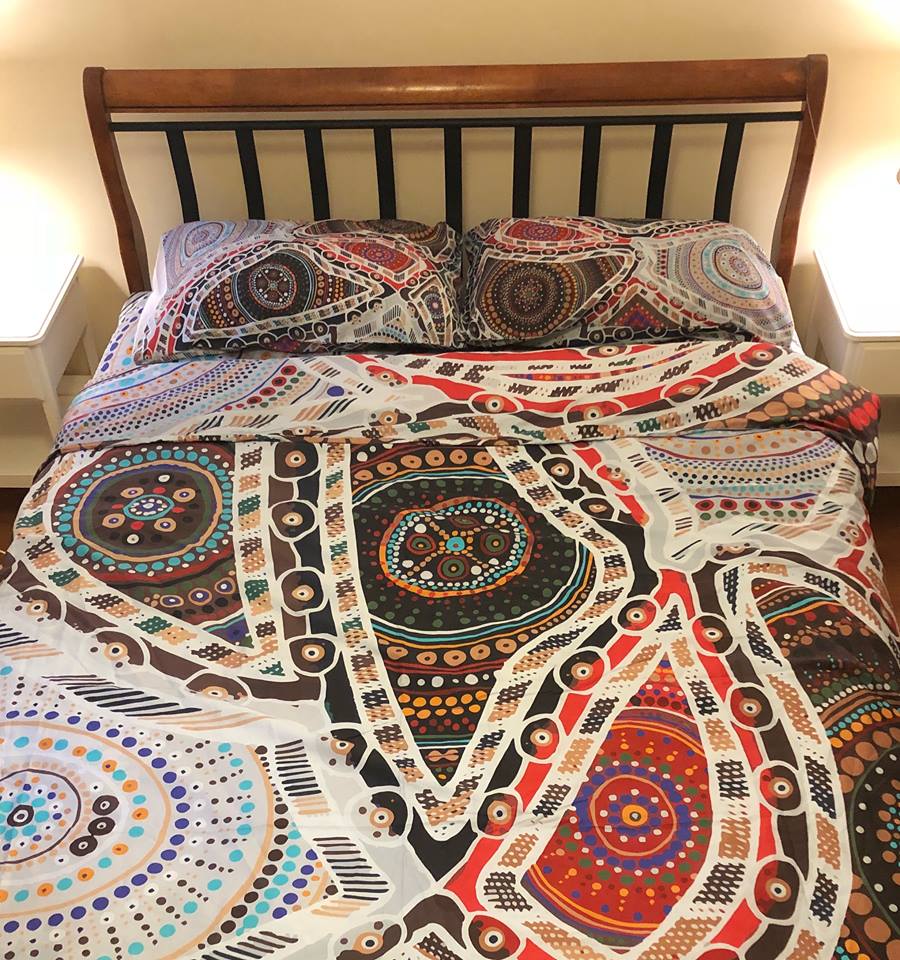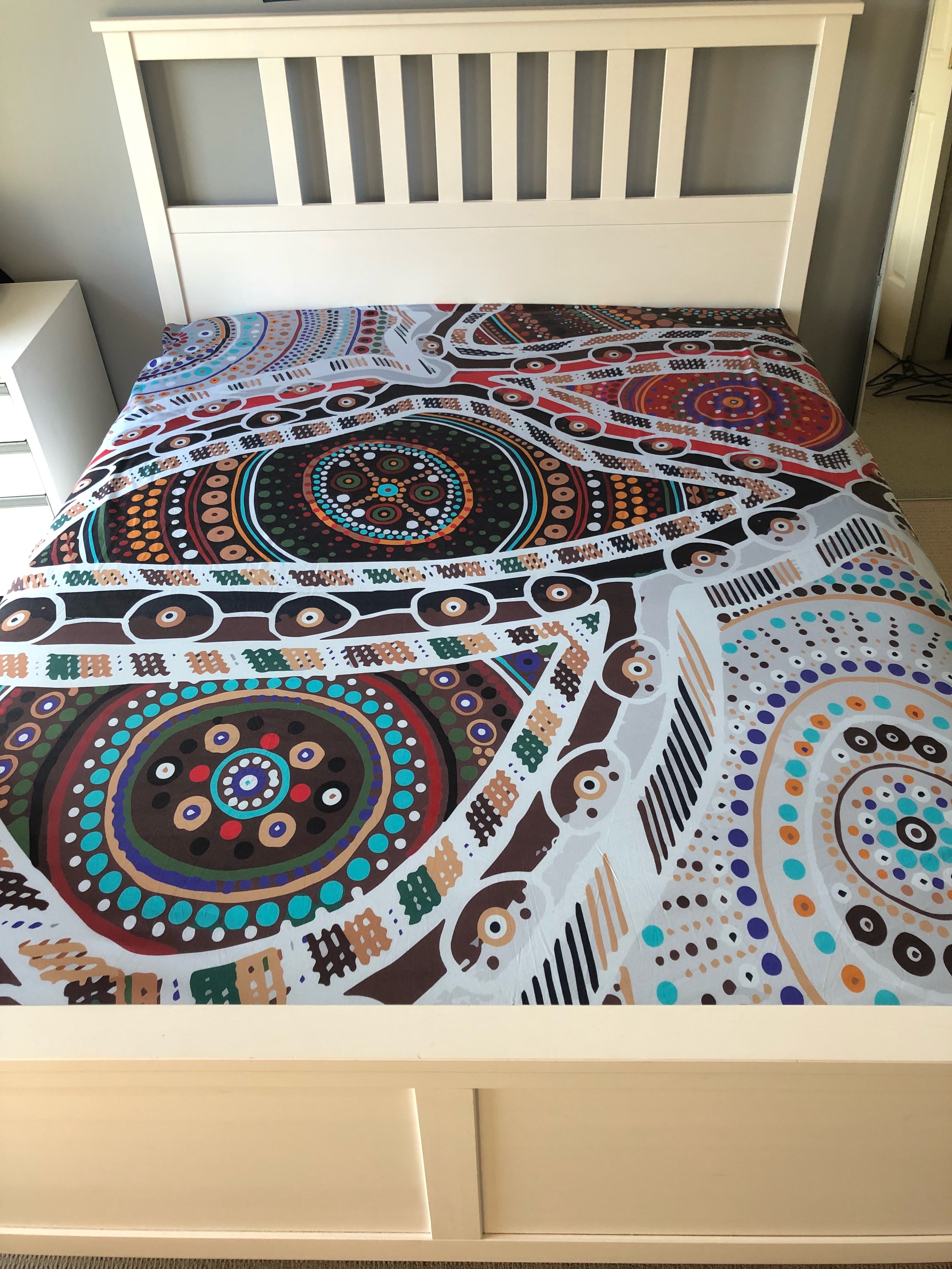Mimmim: Making Aboriginal art accessible through beautiful bedsheets
Aboriginal art in the Australian continent – dating back to almost 60,000 years – not only chronicles and informs about the first Aboriginal settlements but is also an important marker of human ingenuity and creativity. For aeons, Aboriginal Tribes have – in the absence of a written language – relied on non-traditional artistic symbols like ochre drawings on rocks, body paintings, and ceremonial sand art, among others for storytelling, communications and reveal cultural philosophies and customs like Dreamtime or Dreaming to succeeding generations.
Thus, the lack of written records of Aboriginal history makes it impossible to view its art in isolation; independent of the culture that birthed it. For to understand it, one must acknowledge Aboriginal People’s thousands-of-years-old history, their way of life and perception of spirituality, interactions with and struggles against colonialism, and their comprehension of contemporary Australian life in tandem with ancient Aboriginal philosophies.
However, since the formation of Papunya Tula artist cooperative in 1972, Aboriginal art has become tremendously popular across the world with contemporary Aboriginal artists like Clifford Possum Tjapaltjrri and Emily Kame Kngwarreye earning millions of dollars for their artworks.
Today, many Aboriginal artists are using their creativity to make their art more accessible and intimate to non-Aboriginals. Among those leading the change is Meikim Cole (Mim), a 42-year-old Larrakia, Wardaman, Karajarri artist.
Mim is the brains behind the unique enterprise Mimmim, a luxury bedsheet line that effortlessly marries traditional Aboriginal art with more contemporary elements. Spending formative years learning the ancient Larrakia technique of cross-hatching from her mother and aunty, Mim associates Aboriginal art with warm filial love – an emotion that the Brisbane based entrepreneur hopes reflects in her bedsheet designs. When she is not creating luxurious bed covers, Mim spends her time honing her painting skills.
In conversation with TAL, Mim talks about the thought processes dictating her bedsheet designs and other paintings, how her family influenced her love for vibrant colours, and the need for dialogue between Aboriginal and non-Aboriginal Australians about Indigenous art.
Luxury bedsheet printed with Aboriginal art is quite a unique idea. What prompted you to start Mimmim?
I wanted to go beyond canvas paintings and experiment with something uncommon. While researching, I found that Aboriginal art has rarely (if ever) been done on bedsheets, so I decided to give it a shot.
If people fill their walls with Aboriginal art, they will soon run out of space; there are so many beautiful artworks out there! I wanted to give my customers a statement piece that can be folded away when not in use. I absolutely love printed and patterned bedsheets myself and believe that the bed is one of the largest “canvases” in a home. So, why not wrap yourself up in one of my bedsheets and feel the fabulous energy and love that I think is reflected in my paintings?
Considering your rich indigenous background (Larrakia, Wardaman and Karajarri), how have Aboriginal drawings, motifs, patterns and colours inspired you? And, how do you blend the traditional elements of your art with the more modern ones?
One of the most prominent traditional techniques visible in all my paintings is cross-hatching. This is a traditional Larrakia technique that I’ve been obsessed with since I was a kid. Watching my family sit together and paint beautiful, neat lines swiftly and effortlessly with long brushes, has always been one of my most cherished childhood memories. I remember being fascinated at how entwined the lines looked despite being painted separately. My mother later taught me to paint in a similar fashion.
My art, I believe, has a two-pronged objective; celebrate my roots and lineage through its intricate motifs and traditional elements, and to creatively present Aboriginal art for a contemporary audience, thereby creating more awareness about my people’s customs and traditions.
How has the reception to the bedsheets been like? And are you planning to venture into other kinds of homewares?
The response has been amazing! Even better than I’d ever expected. I was overwhelmed and humbled by the immense support I received from my community, and others. I hope that my honest, open and warm interactions with customers help me build a competent and attractive brand. I would like to break into the mainstream market because I want everyone to enjoy my creations.
I am thinking about venturing into other verticals of homewares too. After all, the possibilities are endless. I had an excellent response to a post I put recently on Facebook and Instagram asking my followers what else they’d like to see my prints on, and I got a lot of exciting ideas. I would love to do something unique and use Aboriginal art in a way it hasn’t been before.
What is your thought process behind each design; how do you conceive a particular composition? Please take us through the process.
The best way to describe my creative process, from planning to execution, is not overthinking! I don’t like to plan out my paintings too much and obsess about how the end product will look. I am instinctive and enjoy going with the flow. I let my creative and spiritual process take precedence over analytical thinking and intuitively decide on colours and patterns that can be used.
My paintings often reflect things that I hold dear - identity, family, country, nature and my community. I can have a story or a preference in my mind, but there’s no telling how the final product will be. This non-analytical and unmethodical practice gives me great joy and turns the whole creative process into a form of meditation and healing.
Which artists (Aboriginal or other) have inspired you the most and why?
My first biggest inspiration is my mother. Growing up I would watch her paint for hours at a stretch and was always mesmerised by her steady hand and creative mind. My large family comprising many gifted artists, and my sister-in-law Charmaine have all influenced me in many ways – sharing an interest in art, having conversations around it and painting together.
I continue to be inspired and motivated by so many amazing people, and up and coming artists I encounter daily. Their talent and unique styles encourage me to work harder and incorporate newer techniques into my art.
However, when it comes to colours, my mother and aunty have been my biggest influencers. My aunty Nadine who is like an elder sister to me is also an artist and loves vibrant colours, which is often reflected in her dress sense. From her, I learnt to merge colours and patterns to create art that speaks to the viewer at an emotional level. My enduring love of mandalas also echoes in my paintings.
As one moves away from Northern Territory towards cities like Sydney, Melbourne or even Perth, awareness about Aboriginal arts seems to wane. How do you think the status quo can be changed? Do you feel non-Aboriginal people are hesitant to purchase Aboriginal artwork for the fear of being culturally insensitive?
I feel there’s always room for improvement in terms of being informed about Aboriginal people and their history in general. As for Aboriginal arts and artists, I have noticed that there are a lot of non-Indigenous people who love our art and want to buy, wear, or hang them as showpieces in their homes but are concerned about being culturally insensitive. The hesitation on their part shows that there is indeed a great deal of respect accorded to Aboriginal traditions and artists today.
Personally, I would love for non-Indigenous Australians to purchase my products. I think it is a mark of unity and respect, and also an opportunity to support Aboriginal art and artists. If you are unsure or are scared that you might offend our sensibilities, strike up a conversation with our Aboriginal mob; they will be more than willing to share their stories. If more non-Indigenous people can understand that Aboriginal art, for us, is our indestructible link to our identity, land and culture, they will be able to appreciate our art better. For this to happen, a robust dialogue on Indigenous art needs to occur between Aboriginal and non-Aboriginal people.
Were you always interested in art growing up? And, are you a designer by profession, or are designing and painting your hobbies?
I’ve been creating art since I was a teenager, learning techniques through practice and observing my mother, uncles and other family members. Art has been an integral part of my life growing up.
I’d like to say I am a designer by profession as I am currently doing my art full time, along with managing a business and looking after my family. However, my art is yet to help me generate an income!
Apart from Mimmim, what other projects keep you busy?
I am involved in many other projects; undertaking commissioned paintings and designs for different organisations and groups, a possible collaboration with a mental health organisation, and donating artworks to various causes.
Being a creative person, I am open to new, exciting and challenging projects and ideas (including community-oriented ones) that come my way.
Another project I am passionate about is the Balunu Foundation that my husband and I co-founded in 2006. It is a charity dedicated to breaking the cycle of Indigenous youth disadvantage by addressing the underlying issues that they are dealing with. Now that I have moved to Brisbane I am not as hands-on as I would have liked with the Foundation. But I am one of the Board of Directors and still help drive Balunu’s vision forward while pursuing my art.
What are your future plans with regards to your brand?
I would love to expand my art and creativity into other verticals of homewares and other industries. That’s the beauty of art; there are no limits to what one can create. I’ve still got so much to learn in business and art. Let’s see where the universe takes me.
Check out Meikim’s beautiful bedsheets on her website.
Connect with her on Facebook and Instagram.
Preferences in terminology when referring to Aboriginal and/or Torres Strait Islander peoples.
Read more about the origin and trajectory of Aboriginal art.












